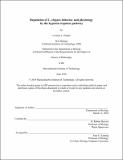Regulation of C. elegans behavior and physiology by the hypoxia-response pathway
Author(s)
Pender, Corinne L. (Corinne Lenore)
DownloadFull printable version (41.55Mb)
Other Contributors
Massachusetts Institute of Technology. Department of Biology.
Advisor
H. Robert Horvitz.
Terms of use
Metadata
Show full item recordAbstract
The transcriptional response controlling adaptation to internal and environmental hypoxia is broadly conserved in animals. The key mediator of this response is the transcription factor HIF (hypoxia-inducible factor), which is active only in hypoxia due to the function of its negative regulators, the prolyl hydroxylase EGLN and the E3 ubiquitin ligase complex recognition subunit pVHL. HIF drives transcription of hundreds of targets that promote hypoxia adaptation. Recent work has also described important and broad roles for HIF outside of the traditional hypoxia response, including functions in immunity, oxidative and other stress responses, and behavior; how HIF targets drive these aspects of animal physiology is poorly understood. In this dissertation, I describe genetic analyses of the nematode C. elegans that have provided insight into the function of HIF targets in regulating animal physiology and behavior. The EGLN family was defined by the C. elegans homolog, EGL-9. Prior to the identification of EGL-9 as a HIF hydroxylase, our laboratory discovered the egl-9 gene from studies of egg-laying behavior. egl-9 loss-of-function mutants, in which HIF is constitutively active, are egg-laying defective; the mechanism regulating egg laying downstream of HIF has been unknown. From a screen for suppressors of the egl-9(lf) egg-laying defect, we identified the gene cyp-36A1, which encodes a cytochrome P450 enzyme and is likely a direct transcriptional target of HIF. In addition to modulating egg-laying behavior downstream of HIF, CYP-36A1 controls expression of more than a third of HIF-upregulated genes and regulates multiple stress responses. A screen for suppressors of cyp-36A1(lf) identified the nuclear hormone receptor NHR-46. We propose that CYP-36A1 functions as a hormone biosynthetic enzyme for the ligand of this receptor, thus mediating gene expression changes that alter stress physiology and behavior. We also found site-of-action and genetic evidence for at least one additional pathway acting downstream of EGL-9 and HIF-1 to regulate egg-laying behavior. These studies have identified novel HIF effectors that broadly affect physiology and behavior in C. elegans, and reveal new avenues for future work on regulation of HIF-controlled biology.
Description
Thesis: Ph. D., Massachusetts Institute of Technology, Department of Biology, 2018. This electronic version was submitted by the student author. The certified thesis is available in the Institute Archives and Special Collections. Cataloged student-submitted from PDF version of thesis. Vita. Includes bibliographical references.
Date issued
2018Department
Massachusetts Institute of Technology. Department of BiologyPublisher
Massachusetts Institute of Technology
Keywords
Biology.